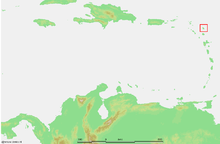- Barbuda
-
Barbuda 
Geography Location Caribbean Sea Coordinates 17°37′N 61°48′W / 17.617°N 61.8°WCoordinates: 17°37′N 61°48′W / 17.617°N 61.8°W Archipelago Leeward Islands, Lesser Antilles Area 160.56 km2 (61.993 sq mi) Highest elevation 38 m (125 ft) Highest point Highlands Country Antigua and BarbudaLargest city Codrington (pop. 1,252) Demographics Population 1,370 Density 9.34 /km2 (24.19 /sq mi) Barbuda is an island in the Eastern Caribbean, and forms part of the state of Antigua and Barbuda. It has a population of about 1,500, most of whom live in the town of Codrington.
Contents
Location
Barbuda is located north of Antigua, in the middle of the Leeward Islands. To the south are the islands of Montserrat and Guadeloupe, and to the south and west are Nevis, St. Kitts, St. Barts, and St. Martin.
History
The Ciboney were the first to inhabit the island of Barbuda in 2400 BC, but Arawak and Carib Indians populated the island when Christopher Columbus landed on his second voyage in 1493. Early settlements by the Spanish and French were succeeded by the English, who formed a colony in 1666.
In 1685 Barbuda was leased to brothers Christopher and John Codrington, who had founded the town of Codrington. The Codrington family produced food on their land in Barbuda, and also transported slaves as labour for their sugar plantations on Antigua. There was more than one slave rebellion at Codrington during the 1740s, during which slaves rose against managers. All the slaves were freed in 1834.
Barbuda was for a time used by the Codringtons as a "nursery" for slaves.[1]
In 1719, Codrington and the island of Barbuda had its first census (of both people and livestock), conducted by Sir William Codrington (1715–1790).
The first map of Barbuda was made in the second half of the eighteenth century. At that time there were substantial buildings in the Highland area, a castle in Codrington, a fort at River, now known as the Martello Tower, and houses at Palmetto Point, Coco Point, and Castle Hill. The map shows eight catching pens for holding captured runaway slaves, indicating that this was a serious problem. There were several defensive cannon gun battery units around the island perimeter. There was a large plantation in the Meadow and Guava area and another large plantation in the Highlands area.
Points of interest
Barbuda is home to the Frigate Bird Sanctuary, which is located in the Codrington Lagoon. Other points of interest include Highland House (the 18th century home of the Codrington family) and the Indian Cave, which contains ancient Amerindian petroglyphs.
Tourism
Barbuda's climate and geography is conducive to tourism. Many tourists are attracted by the island's beaches. Activities include swimming, snorkeling, fishing, scuba diving, hiking, bird watching, and golfing. Several resorts are located on the island.[2].
Geography
The total land area is 160.56 km². The capital and largest city is Codrington, with an estimated population of 1,000. The island is mostly coral limestone island with little topographical variation. The highest point is only 38m above sea level.
Climate
The climate is classified as tropical marine which means that there is little seasonal temperature variation. In January and February, the coolest months, the average daily high temperature is 81°F (27°C). While in July and August, the warmest months, the average daily high is 86°F (30°C).
References
- ^ Barbudaful.net Retrieved 2009-01-23
- ^ The Island of Barbuda Retrieved 2011-09-23
External links
Parishes 
Dependencies Barbuda · Redonda
Categories:- Lesser Antilles
- Islands of Antigua and Barbuda
- Dependencies of Antigua and Barbuda
- Barbuda
- Former English colonies
Wikimedia Foundation. 2010.

